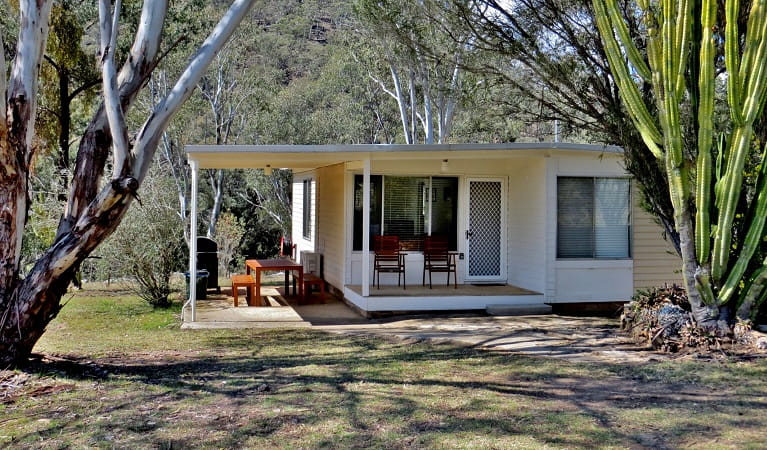Capertee Cottage
Capertee National Park
Overview
Capertee Cottage, offers walking, birdwatching and paddling in a scenic riverside setting, not far from Mudgee within Capertee National Park.
| Accommodation type | Cottage |
|---|---|
| Where | 1048 Port Macquarie Road, Bogee, NSW, 2849 - in Capertee National Park |
| Bedrooms | 2 |
| Maximum guests | 6 |
| Facilities | Barbecue facilities, showers, toilets, electric power, balcony, outdoor furniture, kitchen, plates and cutlery, pots and pans, bed linen, air conditioning, tv, towels, washing machine, rubbish bin |
| What to bring | Drinking water, cooking water, food supplies |
| Please note |
|
Get back to basics with a no-fuss holiday in breathtaking countryside within Capertee National Park, an hour and a half drive from Mudgee. Capertee Cottage, nestled by the picturesque riverside setting, offers adventurous families and friends a great opportunity to go car touring, bushwalking, mountain biking and birdwatching.
Active types will love exploring the nearby tracks on foot or bicycle. If you want something a little more leisurely simply soak in the scenic river views while listening to the chattering lorikeets and honeyeaters.
In the evening, kangaroos and wallabies are often seen grazing nearby. Gather the family and delight in a barbecue under a blanket of stars. You might even hear the call of the powerful barking owl echoing through the bush.
Map
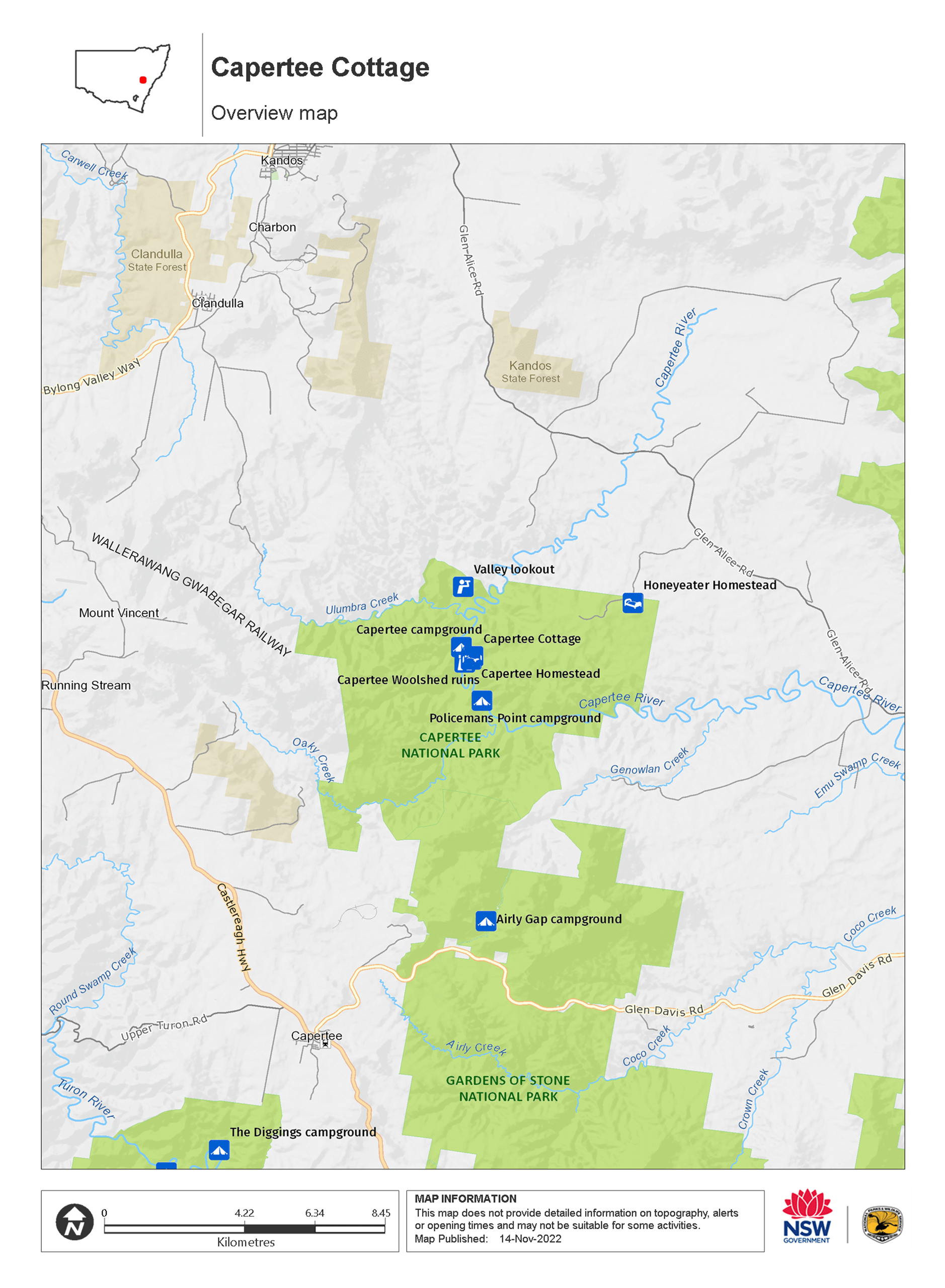
Map legend

Map
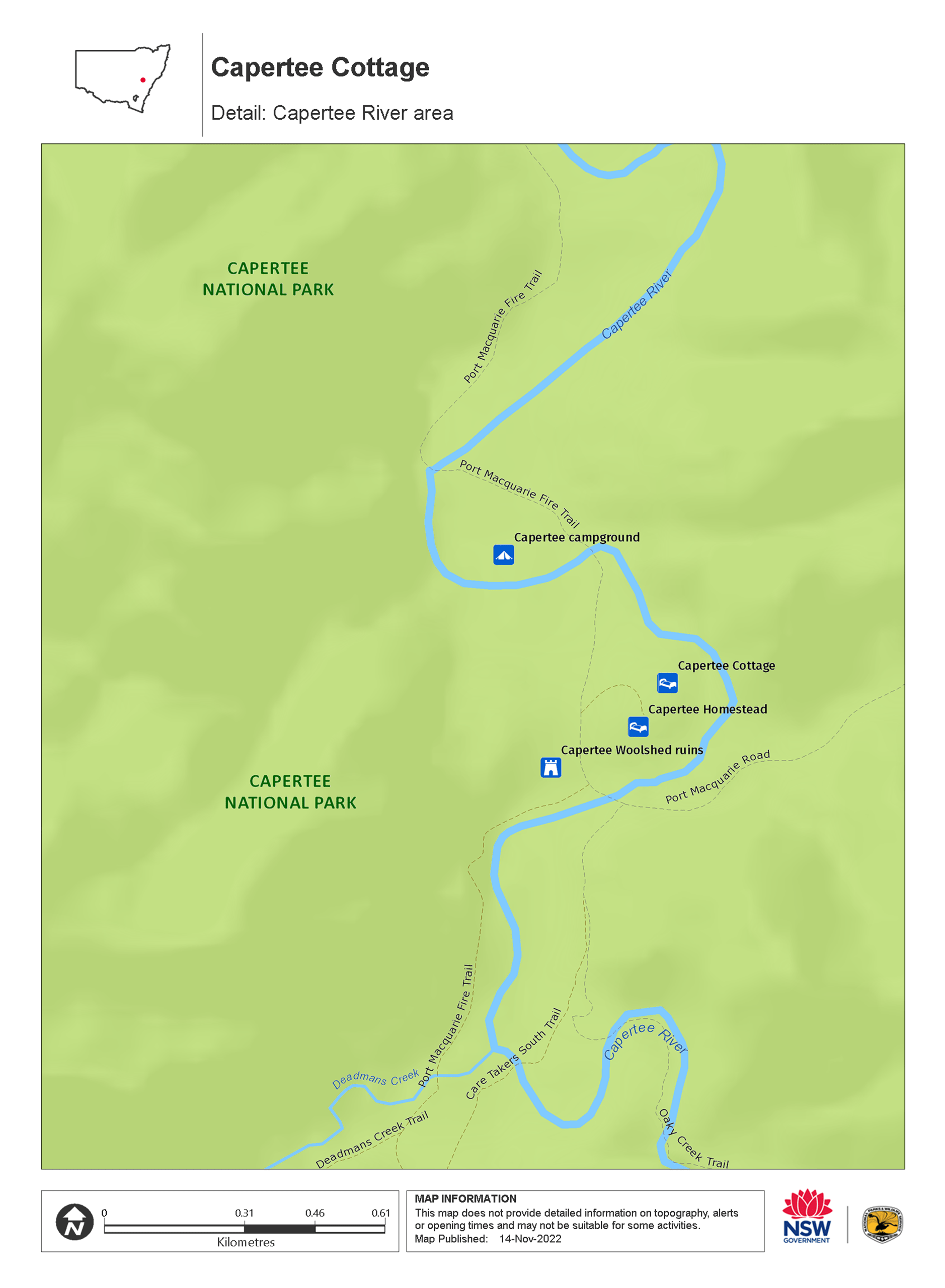
Local alerts
For the latest updates on fires, closures and other alerts in this area, see https://www.nationalparks.nsw.gov.au/camping-and-accommodation/accommodation/capertee-cottage/local-alerts
Bookings
- National Parks Contact Centre
- 7am to 7pm daily
- 1300 072 757 (13000 PARKS) for the cost of a local call within Australia excluding mobiles
- parks.info@environment.nsw.gov.au
Operated by
- Mudgee office
- Monday to Friday, 9am to 4:30pm.
- 02 6370 9000
- npws.mudgee@environment.nsw.gov.au
- 27 Inglis Street, Mudgee NSW 2850
Park info
- in Capertee National Park in the Sydney and surrounds and Country NSW regions
Capertee National Park has a locked entry gate. If you're visiting during the day, get the gate code by calling Mudgee Office (weekdays) or Blue Mountains Heritage Centre (weekends).
Visitor info
All the practical information you need to know about Capertee Cottage.
Getting there and parking
Capertee Cottage is in the northern part of Capertee National Park. To get there:
- Turn on to Port Macquarie Road (unsealed) from Glen Alice Road
- From the locked gate on the park boundary, follow Port Macquarie Road for 5km
- Upon arriving at Capertee River causeway, cross the river and take the road on the right to the cottage and homestead
Important: Follow the instructions and the map provided by NPWS. Don't use Google maps or GPS as this will give you an incorrect route and you may not be able to access the property.
After booking you'll get a code to open the park boundary gate and a door code to access the cottage. Contact 1300 072 757 if you have not received your codes.
Road quality
Please be aware that the cottage is accessed by crossing Capertee River via a causeway. At times of very heavy rain, flooding may occur, preventing access to and from the cottage. Check the weather before you set out or contact the Mudgee office.
- Unsealed roads
Vehicle access
- 2WD vehicles
Weather restrictions
- All weather
Parking
Parking is available at Capertee Cottage.
Best times to visit
There are lots of great things waiting for you in Capertee National Park. Here are some of the highlights.
Autumn
The cooler autumn months are an excellent time for walking and mountain biking the trails and tracks within the park.
Spring
Grab your binoculars for some superb birdwatching. You might catch a rare glimpse of the endangered regent honeyeater as it builds its nest.
Summer
Enjoy a relaxing picnic on the shady banks of Capertee River, or a refreshing paddle.
Winter
Enjoy a car tour of Capertee while taking in nearby Wollemi and Goulburn River National Parks.
Weather, temperature and rainfall
Summer temperature
Average
12.1°C and 25.5°C
Highest recorded
38.4°C
Winter temperature
Average
10.4°C and 0.7°C
Lowest recorded
-8°C
Rainfall
Wettest month
January
Driest month
September
The area’s highest recorded rainfall in one day
179mm
Facilities
- The cottage is fully furnished and has an open plan kitchen, dining and living area, a bathroom, and an outdoor area with seating and a gas barbecue.
- Hot and cold running water is available at the property. You need to bring your own water for drinking and cooking.
- Please leave the cottage clean and tidy and report any breakages, damage or maintenance issues to the Mudgee office.
Toilets
- Flush toilets
Barbecue facilities
- Gas/electric barbecues (free)
Showers
- Hot showers
Electric power
This property is connected to mains power.
Balcony
Outdoor furniture
Kitchen
The kitchen has a fridge and freezer, oven, toaster, kettle, microwave, glassware, and tea towels.
Plates and cutlery
Pots and pans
Bed linen
Bed linen, duvets and pillows are provided.
Air conditioning
TV
There's a TV and DVD player but no TV reception.
Towels
Towels are provided.
Washing machine
Laundry facilities are available in an external building behind the nearby homestead.
Rubbish bin
Please recycle rubbish into appropriate bins.
Maps and downloads
Accessibility
Disability access level - no wheelchair access
Prohibited
Drones
Flying a drone for recreational purposes is prohibited in this area. Drones may affect public enjoyment, safety and privacy, interfere with park operations, or pose a threat to wildlife. See the Drones in Parks policy.
This area may be a declared Drone Exclusion Zone, or may be subject to Civil Aviation Safety Authority (CASA) rules for flying near airports, aerodromes and helicopter landing sites. See CASA's Drone Flyer Rules.
Commercial filming and photography
Commercial filming or photography is prohibited without prior consent. You must apply for permission and contact the local office.
Learn more
Capertee Cottage is in Capertee National Park. Here are just some of the reasons why this park is special:
Looking for things to do in Capertee?
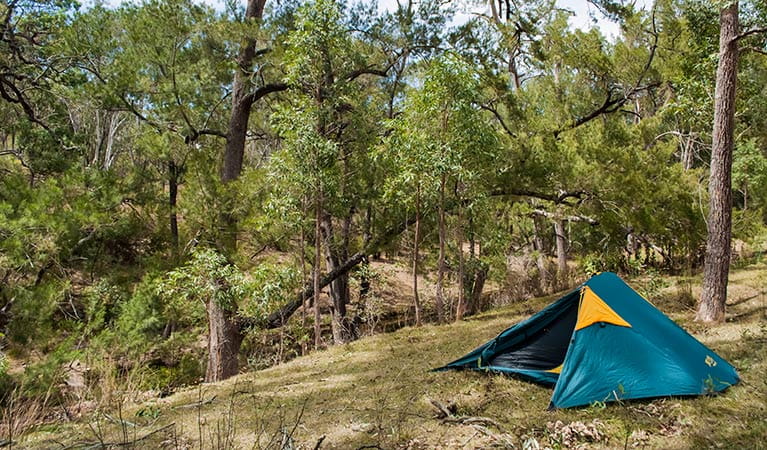
There are great things to do when in Capertee. Enjoy fantastic bird watching any time of the year - the protected woodlands attract the threatened gang-gang and glossy black cockatoos, and Capertee Valley is one of only three known nesting areas for the endangered regent honeyeater. You'll find a range of options if you're looking for a place to stay, including Capertee Homestead, Cottage or campground. Bookings essential. You can also hike into remote Policemans Point campground.
- Capertee Woolshed ruins Capertee Woolshed ruins, in Capertee National Park, offer a view of the historic heritage of the area, with walking, paddling and birdwatching opportunities nearby.
- Valley lookout Relax with a picnic lunch at Valley lookout and enjoy dramatic views inside the world’s second largest canyon. It’s easily combined with a 4WD or camping getaway in Capertee National Park, near Rylstone.
Plant life abounds
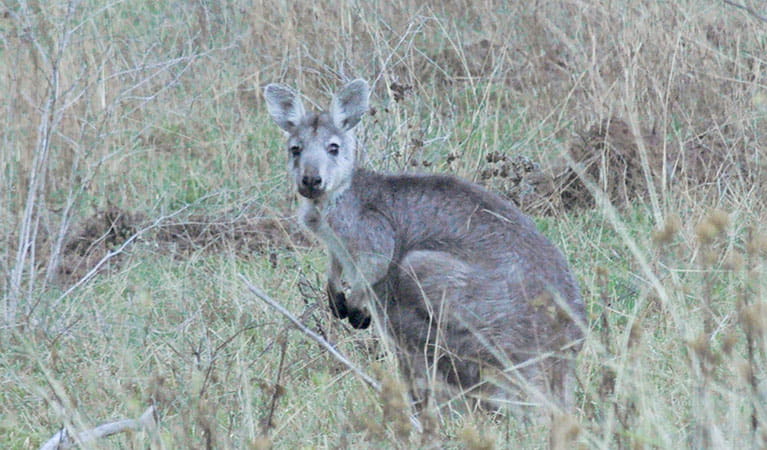
The park is home to rare grey grevillea shrubs, which bloom with pink and red flowers in spring. This hardy, dense shrub is found nowhere else but Capertee Valley. Fertile river flats and surrounding slopes host an ecological community of majestic yellow box, blakelys red gum and white box, providing a vital habitat for wildlife and native birds.
- Capertee Woolshed ruins Capertee Woolshed ruins, in Capertee National Park, offer a view of the historic heritage of the area, with walking, paddling and birdwatching opportunities nearby.
- Valley lookout Relax with a picnic lunch at Valley lookout and enjoy dramatic views inside the world’s second largest canyon. It’s easily combined with a 4WD or camping getaway in Capertee National Park, near Rylstone.
Wiradjuri country
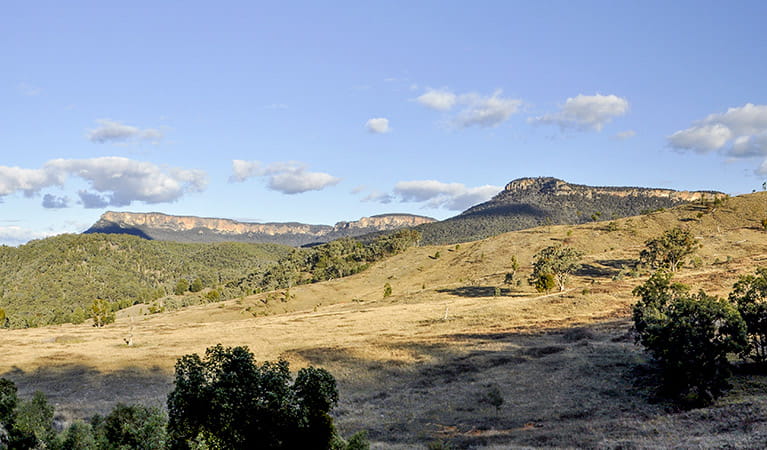
Capertee National Park is within the traditional lands of Wiradjuri People. The surrounding countryside contains evidence of Aboriginal occupation in the form of rock art, scarred trees and artefacts. Traditional food plants and old travel routes are also present within the park.
Plants and animals protected in this park
Animals
-
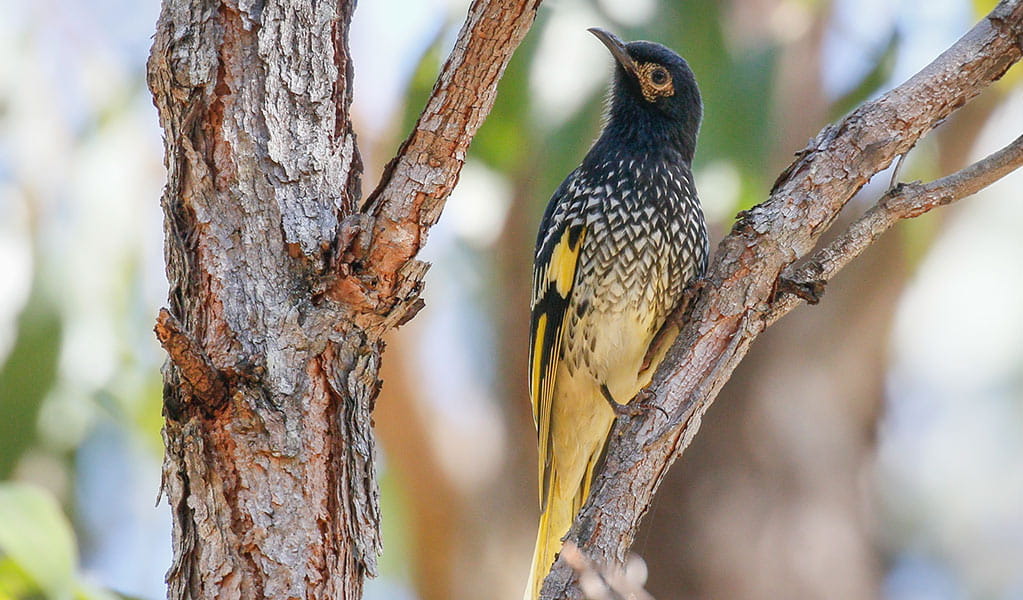
Regent honeyeater (Anthochaera phrygia)
The regent honeyeater is a critically endangered native bird. Once widespread across south-eastern Australia, only around 250 to 350 birds remain in the wild, making it at risk of extinction.
-

Swamp wallaby (Wallabia bicolor)
The swamp wallaby, also known as the black wallaby or black pademelon, lives in the dense understorey of rainforests, woodlands and dry sclerophyll forest along eastern Australia. This unique Australian macropod has a dark black-grey coat with a distinctive light-coloured cheek stripe.
-
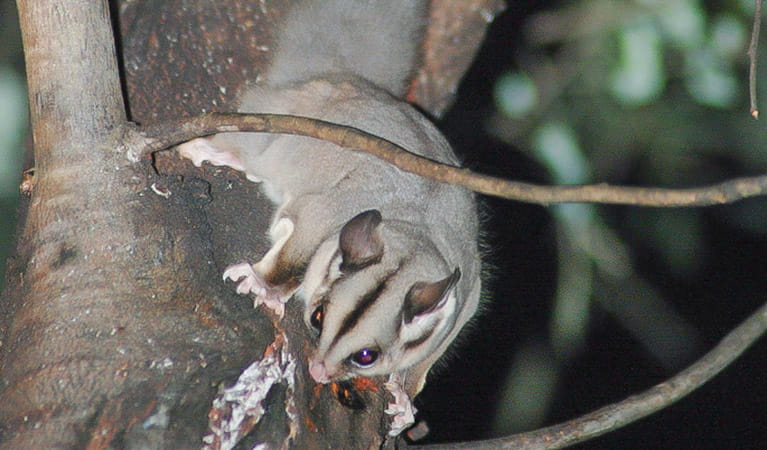
Sugar glider (Petaurus breviceps)
The sugar glider is a tree-dwelling Australian native marsupial, found in tall eucalypt forests and woodlands along eastern NSW. The nocturnal sugar glider feeds on insects and birds, and satisfies its sweet tooth with nectar and pollens.
-

Bare-nosed wombat (Vombatus ursinus)
A large, squat marsupial, the Australian bare-nosed wombat is a burrowing mammal found in coastal forests and mountain ranges across NSW and Victoria. The only other remaining species of wombat in NSW, the endangered southern hairy-nosed wombat, was considered extinct until relatively recently.

